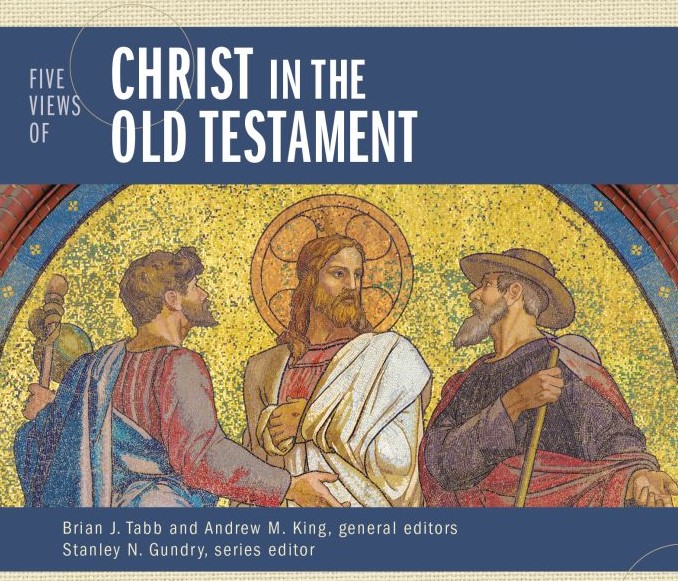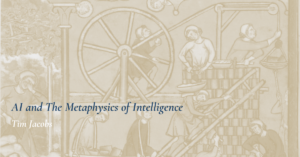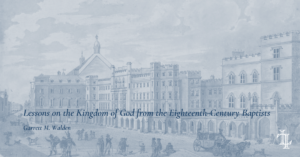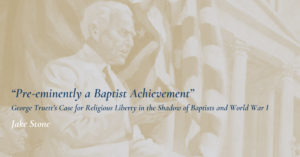Tabb, Brian J. and Andrew M. King, eds. Five Views of Christ in the Old Testament. Grand Rapids: Zondervan, 2022. 322 pages. Softcover. 978-0-310-12551-8. $26.99.
Introduction
In my seminary PhD program I took a seminar on hermeneutics. Only a few of us studied in the biblical studies program, with the rest seeking doctorates in preaching. Our discussions revealed a clear fissure. The “biblical studies guys” felt constant frustration with the “preaching guys” always wanting to draw any and every connection to Christ from Old Testament (OT) texts. Yet, as a full-time pastor preaching weekly, I also sympathized with the latter group’s fervor to preach Christ from the OT.
This anecdote illustrates the problem addressed in this Five Views book. Christians instinctively believe that, in some way, Christ ought to be preached from the OT. Christian preachers know that they ought to preach the OT in a way that, as the saying goes, should not be the same as a sermon in a synagogue or mosque. The big question is how this kind of preaching is to be done. Surely there must be some illegitimate ways to see Christ in the OT. Are the tent pegs of the tabernacle really a reference to Christ because he, too, was in the ground and then came out of it? (See Martin R. DeHaan, The Tabernacle [Grand Rapids: Zondervan, 1955], 65). Should we just read the Bible as postmodernists asking, “What does the text mean to me”? Many would see an equal problem with these approaches as well. Yet which interpretive rules are appropriate when looking for Christ in the OT? Many aspects of this debate are covered in Five Views of Christ in the Old Testament, edited by Brian Tabb and Andrew King.
Summary
In each chapter, one scholar proposes his or her view, which includes each applying his or her method to three case studies (Genesis 22:1–19; Proverbs 8:22–31; Isaiah 42:1–4). Then the others critique the presentation, and the original scholar then writes a brief rejoinder to those critiques. Usually, the critiques provide help in sorting out the differences, though sometimes they are redundant. At times the critiques are hard to understand unless one goes and reads that particular scholar’s own essay first to find out their method.
First, John Goldingay propounds the “First Testament approach.” This approach probably appears most commonly in the “grammatical-historical” and “historical-critical” camps. Goldingay’s concern is to not read meaning back into the OT that was never actually there. He claims that the divine author’s meaning is only what the original human author meant (23). Yet he states, “[W]e are wise to read the New Testament in light of [the First Testament] and to read the two Testaments in light of each other, as both comprise the Christian Scriptures” (21). To read the OT this way, Goldingay’s method relies on a distinction between meaning and significance. The text means only what it originally meant, but can have significance beyond such meaning. The Spirit can illumine passages such that they have greater significance later on. Goldingay provides the example of Matthew’s use of Isaiah 7:14 (24). He writes, “. . . the original text becomes the vehicle whereby the later writer makes a new point and uses the text to this end” (25). So, how is Christ in the OT? Goldingay insists that Christ is in the OT because Jesus is God. Thus, everywhere YHWH is involved, one finds Jesus (26–28). Additionally, God’s acts are typological, but one only sees Jesus there in retrospect (30–31). Finally, one sees Christ in God’s OT promises and threats. Jesus “fills out” these promises (34). As to the case studies, Goldingay predictably interprets them in light of what he thinks the original author meant. He says, “Christ is not in Genesis 22, nor does Genesis 22 point to Christ” (40). As to Proverbs 8, referring to Arius’ interpretation, he claims, “Finding Christ in the First Testament led to heresy!” (42). With Isaiah 42, he argues that national Israel is God’s servant. “There is nothing to give the ancestors the idea that the passage is messianic,” he says (44).
Second, Tremper Longman presents the “Christotelic approach.” Like Goldingay, Longman desires to retain the “original meaning” of the OT, yet he agrees that the OT anticipates Christ. So, while Goldingay would say there’s only one meaning to an OT text, Longman says there are two—the original OT meaning, and then a second retrospective Christian reading (74).[1] The OT has a “fuller meaning” due to divine authorship, but the OT authors were not aware of this second meaning (75, 81). Hence Longman uses the term “Christotelic.” “Christocentric” means that Christ is of the essence of the OT meaning, while “Christotelic” means Christ is the goal of the OT, a goal that is only seen upon its fulfillment (85). Strangely, though, after clear criticism of the Christological (i.e. Christocentric) approach, Longman then says both are legitimate perspectives and that he uses the terms interchangeably (85)! Longman then applies his method to the case studies. The first “discrete” reading of Genesis 22 shows that the story is about Abraham’s faith leading to obedience. The second “Christotelic” reading emphasizes Christ as the substitutionary sacrifice, due to connections of Moriah and the temple, and the language of the beloved son. As for Proverbs 8, the first reading sees Woman Wisdom as Yahweh himself, or at least a personification of God’s wisdom (93). Wisdom participated in the world’s creation. In the second reading we know that Christ personifies God’s wisdom and he, too, was involved in creation. Longman takes pains to clarify that he “associates” rather than “identifies” Jesus with Wisdom. To press Proverbs 8 too literally to be about Christ “leads to the Arian heresy” (95). Finally, Longman identifies the Servant of Isaiah 42 as Israel in the first reading, but in the second reading states that Jesus was “the full realization of the servant” (98).
The third contributor, Havilah Dharamraj, argues for a “reception-centered, intertextual approach.” She adopts a technical term, the “Common Reader,” to describe a general (non-scholarly) reader looking at the OT. The Common Reader intuitively “pairs one text with another” (129). Thus, this approach is “reception-centered,” based on how a reader links texts, whether or not the producer of the text intended a link. Another important aspect of this approach is what she calls the “public meaning” of a text, how a text takes on meaning as it moves through time and cultures. Public meaning can be accrued through sermons, music, visual arts, and more. The Common Reader uses knowledge from these sources to subjectively link texts (130). So, the Common Reader finds an OT text, looks for “christological resonance,” identifies a dominant theme of the christological text, looks for a similar NT christological text, then puts those texts in “free-flowing dialogue” (132), and finally evaluates whether such a reading “deepen[s] the reading of each text . . . toward orthodox Christian faith and practice” (132–133). In her case studies, Dharamraj links Genesis 22 with Philippians 2, Proverbs 8 with Colossians 1, and Isaiah 42 with Revelation 19.
Jason DeRouchie proposes the fourth view, the redemptive-historical, christocentric approach. Unlike Goldingay and Longman, DeRouchie believes that Christ’s person and work inheres in the meaning of the OT text. Scripture has God as author who is progressively unfolding redemptive history centered on Christ. Christ is “innately present” in the OT but often only understood in retrospect (185). The NT’s presentation of Christ fulfilling the OT shows us how the divine author wanted us to understand the OT all along (186). DeRouchie claims his method involves “rigorous exegesis and theology” to follow the signals God places in the text (187). This involves identifying three contexts. The “close context” studies the immediate literary context of the book. Next, the “continuing context” considers redemptive history, e.g. the OT use of OT, progression of covenants, or typological patterns. Third, the “complete context” looks at the text in light of the whole canon. He sees seven possible ways of identifying Christ in the OT: direct prediction, salvation-historical trajectory, compare/contrast of old and new ages, typology, Yahweh’s identity and activity, ethical ideals, and a guide in the law of love. In his case studies, DeRouchie applies complex exegesis of the text and biblical book to see Christ there. He interprets Genesis 22 as God’s test of Abraham about whether he believes Yahweh will provide a singular male offspring through Isaac (192). Yahweh typologically confirms and directly predicts that he will provide such (199). As to Proverbs 8, DeRouchie argues that Solomon portrays Wisdom as God’s eternally begotten Son who would be incarnate in the royal Son of David (203). With Isaiah 42, he claims that Isaiah presents and directly predicts a king, servant, and anointed conqueror who would mediate a covenant for the people (210).
Finally, Craig Carter advances a premodern approach. Prior to the rise of historical criticism and the Enlightenment, the “mainstream” of Christian scholars saw Christ in the OT through prophecy, typology, the “spiritual sense” of the text, through recapitulation of Israel, and through prosopological exegesis (239–240). Carter critiques modern assumptions of interpretation, such as how human authorial intent can be decisive in meaning while simultaneously “read[ing] Jesus into the OT” (241). Instead, he argues that the apostolic teaching derives from reading the OT Scriptures in light of Christ. He writes, “It has never been demonstrated that Nicene and Chalcedonian orthodoxy can be derived from exegesis that strictly employs only the historical-critical approach” (242). Carter admits the difficulty of encapsulating a method of “premodern interpretation.” The approach entails a spiritual reading of Scripture. One can use scholarly resources, but the goal is to hear God speak. He defines the literal sense of the text as, “. . . the divine author’s intended meaning as communicated through the human author’s words” (243). Carter spends a great deal of space proving that this is simply how the early church saw Scripture. The NT, he claims, is simply an interpretation of the true meaning of the OT (248). However, he later presents a few hermeneutical rules. One is that unity inheres in Scripture. Therefore, Scripture cannot contradict itself, its unity is in Christ, and texts shed light on one another. The second rule is the priority of the literal sense. Any “fuller sense” cannot contradict the literal sense, and the former must somehow be logically related to the latter. Texts contain layers of meaning but not conflicting meanings. The third rule states that a spiritual sense exists in the text. Carter, referencing Aquinas, states that the spiritual sense is an allegorical sense signifying Christ, a moral sense, and an anagogical sense relating to eschatology. The fourth and final rule is that the Christological meaning controls interpretation of the text. As to the case studies, Carter sees in Genesis 22 that Isaac is a type of Christ, in Proverbs 8 that Wisdom denotes the preexistent Son, and in Isaiah 42 that the Servant is both Israel and Jesus Christ as the embodiment of Israel.
Evaluation
The editors made some interesting choices when contracting contributors for the book. First, out of the five contributors, Craig Carter is the only one who is not a biblical scholar, but a theologian. Of course, one should evaluate his argument, not the person making it. The point in raising the issue is to ask if there actually are any OT scholars who use his approach and could make a case for it. Is OT scholarship too modern? Do we have a major problem if those trained in studying the OT cannot articulate Carter’s view of Christ in the OT? A second observation is that the editors selected Havilah Dharamraj to present the argument for a “reception-centered, intertextual approach.” The readers concerned with the book’s subject (likely evangelicals, and especially preachers) will find this approach completely out of bounds because of the “subjectivity” of this “reader-response method” (130). Since only five views could be considered in this volume, a more fitting selection for the likely intended audience would have been a canonical, intertextual approach, such as that exemplified in scholars like the late John Sailhamer, or Mark Gignilliat. Reading the Bible in terms of its canonical composition is a more prominent way than the one Dharamraj espouses. Finally, in terms of the selection of contributors, consider that, aside from Carter, the four other contributors are OT scholars. The editors selected no NT scholars, which is noteworthy because trained NT scholars often downplay the original OT context. In other words, the editors show that one can be trained in OT scholarship and still desire to see Christ there. One does not simply see Christ in the OT because the NT quotes the OT.
My own view lies closest to that presented by DeRouchie. However, I wonder if DeRouchie is making too much out of his peculiar exegesis of texts. For example, I question the claim that Wisdom in Proverbs 8 is meant to be the royal son mainly because Proverbs is presented as Solomon’s instruction to his royal son. I believe the redemptive-historical method is helpful because it encourages the reader to dig for textual links between passages, books, and the whole canon. However, we also run the danger of seeing links that do not actually exist. When there is no direct textual link, I often turn to the simple conclusion that Goldingay writes of. Jesus is YHWH. What we see about YHWH in the OT, we see of Jesus in the NT. So, in preaching on creation, for example, it is appropriate to speak of Jesus as the one through whom God creates all things in Genesis 1.
I agree with much of what Carter writes in terms of his theological conclusions and hermeneutical presuppositions. However, Carter does not explain his method enough to be convincing. The closest he comes is mentioning Aquinas’ fourfold sense (of course, the quadriga is not unique to Aquinas). I am not persuaded that the quadriga should be followed above any other method, though Carter rightly criticizes the bad fruit of modern scholarly methods. So, how exactly does one use the resources of scholarship while also coming to the spiritual sense of the passage? In addition, Carter states that the literal sense takes priority (252). The spiritual sense cannot contradict the literal sense. Yet he had earlier defined the literal sense as “. . . the divine author’s intended meaning as communicated through the human author’s words” (243). This definition sounds like the literal sense is the spiritual sense. So, for example, many believe that the “literal sense” of Isaiah 7 is that a young married woman in Isaiah’s day would have a son named Immanuel. If that “literal sense” takes priority, how are Isaiah’s words about Mary and Jesus? Doesn’t the “fuller sense” contradict the “literal sense”? I am sure Carter would say no, that the fuller sense expands the literal sense. Yet he does not explain how something can expand but not contradict the original sense. The problem here is that there really is no clearly fleshed-out method. Carter writes, “All interpretations of Old Testament texts are subject to the control that is placed on the interpreter by the ontological reality to which those texts witness. . . . [The meaning] does not ‘belong’ to the individual interpreter. . . . It belongs to the Triune God” (255). The question, then, is how does one determine what that ontological reality that text witnesses to? How does one find the meaning that belongs to the Triune God?, I agree with Carter’s conclusions, but am not clear on how he gets there. Thus, I find the redemptive-historical approach to be more textually based.
One more point of critique of the book consists in that nobody addressed the question of the human author, that is, the role of the canonical shaping of Scripture. Authors like Goldingay and Longman seek to give priority to the “original meaning” of the OT author, yet the divine author clearly superintended a canonical shape to the Scriptures, as evidenced in the ordering of the Psalms and a text as simple as Deuteronomy 34 (Moses did not write of his own death). More and more research is being done on, for example, the Book of the Twelve (“Minor Prophets”) regarding how they can legitimately be read in light of each other and how this canonical shaping points to Messianic expectation. This approach fits with DeRouchie’s redemptive-historical reading, but looks at the text in light of the canon, not just the salvation-history. The approach also underlines Carter’s assumption of the Triune authorship of Scripture whose message centers on Jesus Christ.
Personally, I do not often enjoy the “multiple views” volumes one finds in various publishers’ series. These series tend to promote an overly-ecumenical view that sees all options as equally viable. However, on matters of orthodoxy, such as the doctrine of hell, all views are not equal. This volume, in contrast, largely involves an inter-evangelical debate. For this reason, even if one disagrees with a particular scholar’s presentation of the view, one can see in each view a good desire to rightly interpret the OT. In this volume, Dharamraj’s view was the least beneficial. Her method is admittedly subjective (130–131), and does not necessarily take into account the original meaning of the text.[2] Moreover, the Common Reader is by definition uneducated in scholarly knowledge of the text (127–128), and so could come to make inappropriate connections.[3] Aside from Dharamraj, Goldingay’s perspective provided provocative points, major disagreements notwithstanding. Longman also challenges the reader to not “jump ahead” to the NT without intently studying the OT text first. This book is a relatively easy read and is worth the time of those seeking to preach Christ in all the Scriptures (Luke 24:27).
[1] Longman uses the word “reading” to describe his method, though in one place he says, “I think it is correct to speak of a deeper meaning of a text . . .” (81, emphasis mine).
[2] She writes, “[A]uthorial intention is not a driving consideration . . .” (131). These critiques are also noted by Goldingay (156) and Longman (160). In describing the Common Reader, Dharamraj cites Virginia Woolf, “Above all, he is guided by an instinct to create for himself, out of whatever odds and ends he can come by, some kind of whole” (128).
[3] As DeRouchie says, “Yet even if most Common Readers give little thought to an author’s intent, the interpreter’s role at any level is not to be a Common Reader but an Ideal Reader” (165). By “inappropriate” I do not mean heretical. Dharamraj is clear that one of the checks of her method is “orthodox Christian faith and practice” (133). Instead, I mean inappropriate as it relates to the meaning of the OT text. For example, what might keep the Common Reader from connecting Balaam’s donkey to the donkey Jesus rode into Jerusalem on (Matthew 21)?
Author
-

Drew N. Grumbles received his Ph.D. in Old Testament from Southeastern Baptist Theological Seminary. He is the author of YHWH Is There, a study of Ezekiel 40–48 using typology. He has served as a long-time pastor and is a contributor to the Spanish Daily Dose of Hebrew (Dosis Diaria de Hebreo). He currently lives in upstate New York with his wife and three children, serving at Albany Baptist Church.
View all posts



